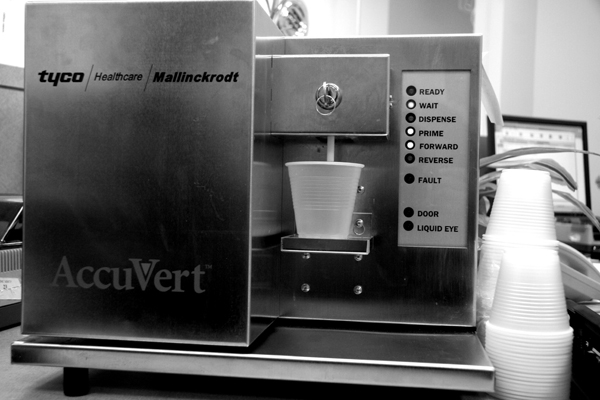
Photo by: Lizzie Ford-Madrid
A methodone machine. Drug courts are seen as a way to keep addicts on treatment regiments without putting them behind bars.
The details of how the latest Rockefeller reforms will affect the state’s 175 drug courts are still up in the air, but what happens every day in Brooklyn Treatment Court might be the model.
People arrested in Brooklyn for felony drug possession or sale who meet a list of eligibility criteria for the treatment court are chosen by the district attorney’s office to participate. They are given the option of pleading guilty to a reduced misdemeanor charge and entering a court-approved drug treatment program. The defendants who comply with the court-mandated treatment have their charges dismissed. The average graduate typically takes about 18 months to finish.
From June 6, 1996, when the treatment center opened, to June 30, 2008, 3,809 people arrested for drug felonies in Brooklyn have participated in the program and about half graduated and had their cases dismissed. Thirty-five percent failed and had sentences imposed, and another 5 percent stopped attending treatment and had warrants issued for their arrest. Nine percent were still receiving treatment as of last June.
The court operates as a “collaborative team” including the judge, prosecutor, defense attorney, clinical staff and even court officers. There are also eight social workers, a doctor who does health screening, an employment coordinator and a computer learning center.
On March 31, Brooklyn Treatment Court alternately resembled a toned-down episode of Judge Judy and a Narcotics Anonymous meeting. After each case was called, Judge JoAnn Ferdinand greeted the defendants and asked how they were doing, as she scanned the defendant’s urinalysis, treatment attendance and discipline records on the court’s computer system. “Are you taking your medicines?” “Tell me about this curfew violation.” “You have not been truthful about your employment, have you?”
A guy who hadn’t showed up to treatment in four months and had been arrested in the interim was sent to prison for 18 months. But for the most part, it was a positive day in drug court: A 20-year-old said he is starting his second semester at Kings College; a woman received a certificate from Ferdinand for being drug-free for four months; Richard Martino, perpetually on the verge of having the judge send him off to prison, appeared to have finally turned the corner. “You should have given up on me a long time ago, but you didn’t,” Martino told the judge.
While drug reformers see drug courts as preferable to prison, the courts do have critics. Drug courts can be extremely selective in choosing defendants. In 2007, the city’s drug courts were referred a mere 7 percent of drug cases, and some 40 percent of those referred were rejected by the courts as unfit for treatment.
Each court has its own restrictions. In Brooklyn, for instance, the DA won’t allow anyone into the program who has previous arrests for “offenses against public order,” which include loitering. The Bronx and Queens drug courts are for misdemeanants only, while Staten Island’s is exclusively for felony offenders. It remains to be seen if the drug courts’ capacity and criteria can handle what the Rockefeller reforms are about to throw at them.








